
Main Cell Block, 2019-20
Project aim: address urgent conservation needs, particularly rising damp, and deteriorating original lath and plaster ceilings.
Initial stage of longer term works to conserve and interpret the entire Cell Block.
Significant archaeological finds were discovered under floorboards and are the subject of ongoing study.
North Perimeter Wall and Gun Posts Conservation Works, 2019
The Perimeter Walls and Gun Posts were vital elements in the security of the Prison, constructed over time as the Prison expanded. The Gun Posts, upgraded with asbestos in the 1960s were in very poor condition.
Project aim: conservation works to Knutsford Street wall, to complete conservation works to the Perimeter Walls and refurbishment of three Gun Posts, including:
- reconstruct walkways
- remove asbestos
- replace roofs
- repair and paint
Partially Commonwealth grant funded.
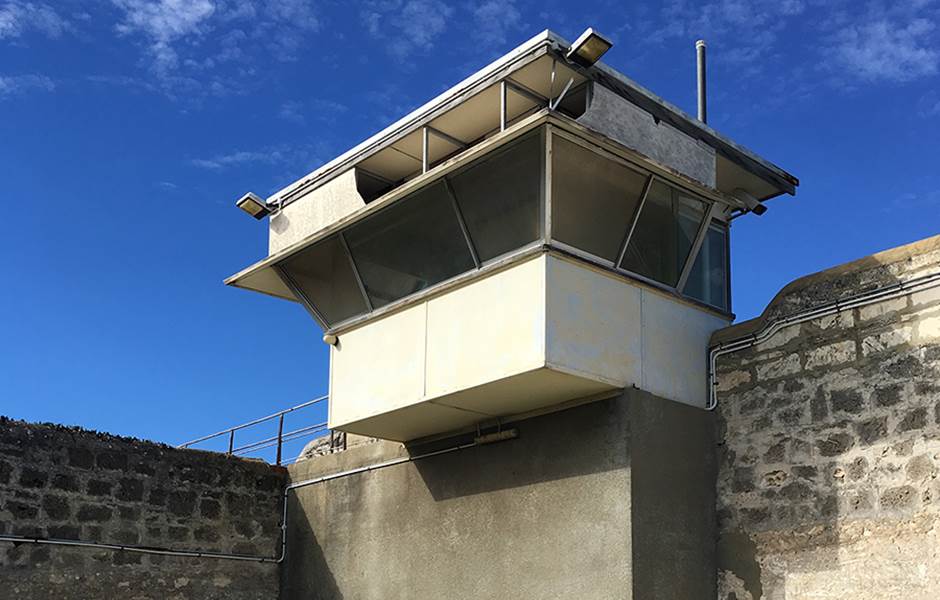
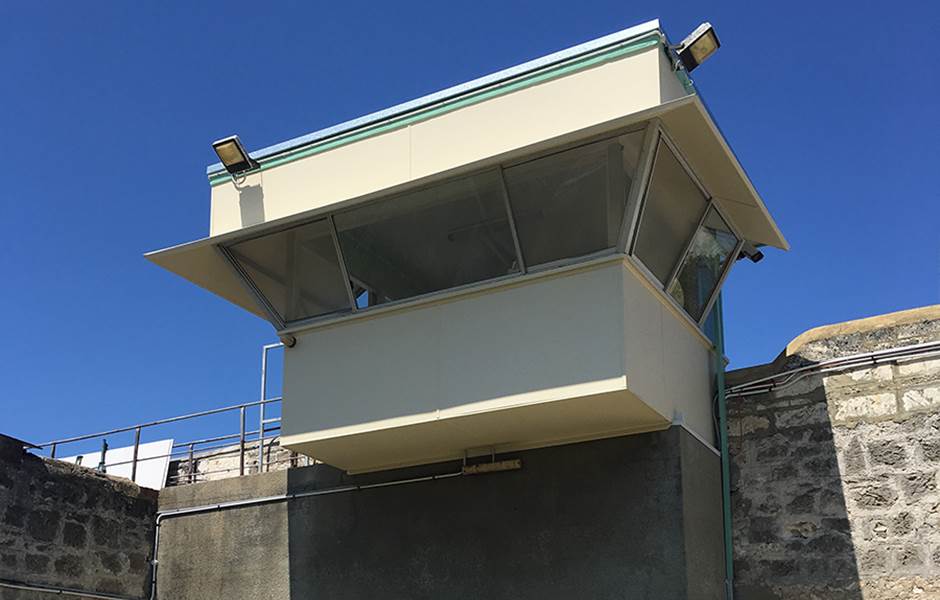
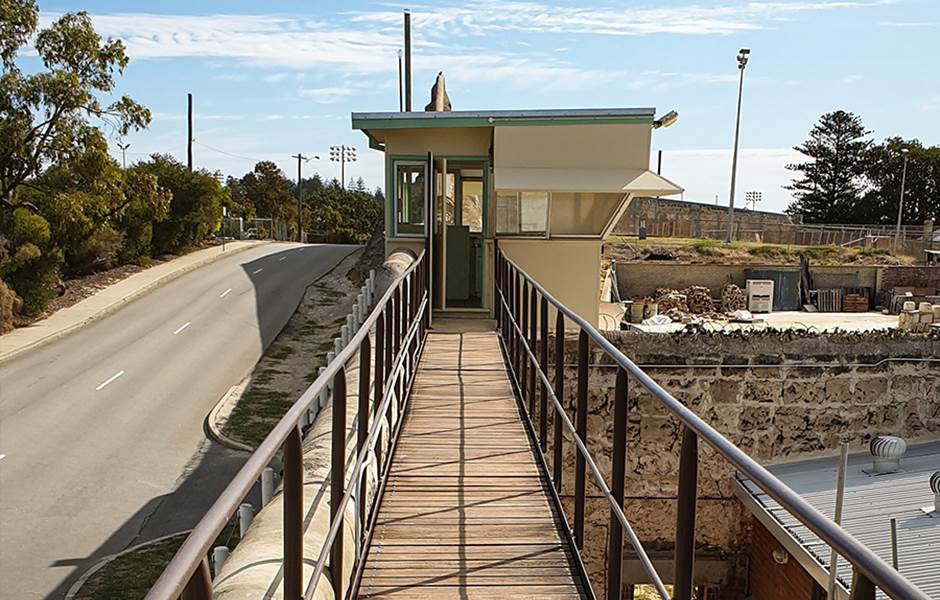
West Workshop Stone Conservation and Roof Works, 2019
The West Workshops were constructed in 1907 to provide workshops for prisoners to work in a tailor’s shop, boot shop and print shop. The workshops now contain curatorial spaces for the Prison, including a gallery and the Visible Collection; and the kitchen of the Youth Hostel.
Works included:
- Stone conservation to the external walls
- Replacement of roof sheeting to waterproof the workshops
- Repairs to timber joinery
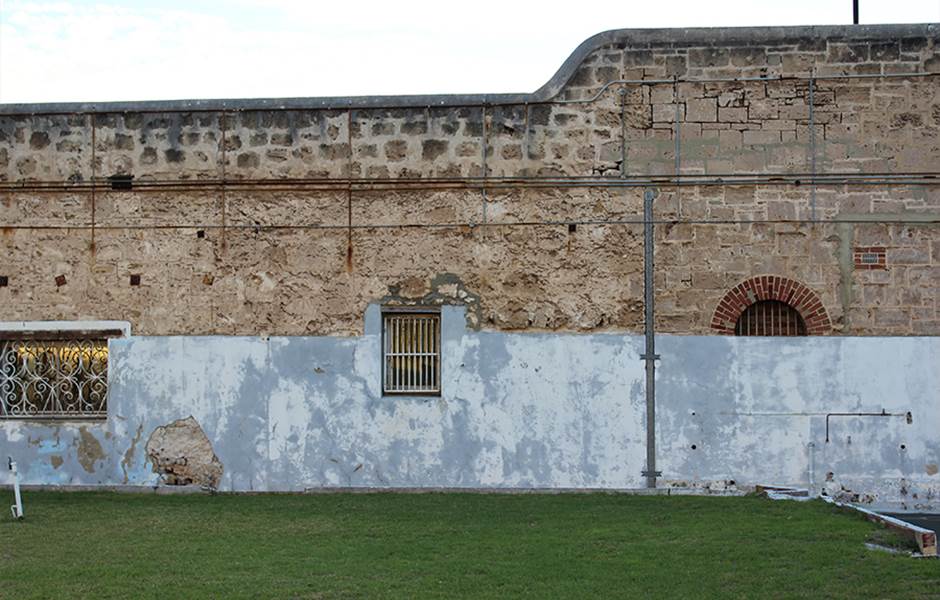
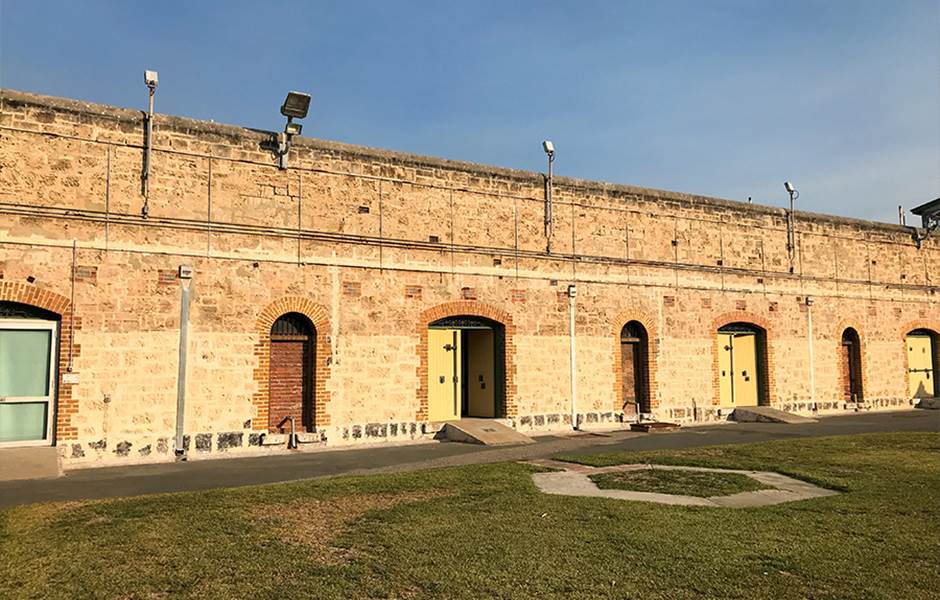
No. 8 The Terrace Reroofing, 2019
No. 8 The Terrace was constructed c.1857 for the Prison Chaplain. It continued as a residence for Prison officers, and in the final years of the Prison was their staff club.
The roof was replaced, having come to the end of its useful life, and after its removal, a lath and plaster wall to an upstairs bedroom was revealed.
Works
- Remove existing roof
- Replace roof to match existing
Canteen and Shower Roof Replacements, 2019-20
The Canteen comprises an earlier Clothes Store, and a 1960s extension with offices. The Showers, located at the south end of the Prison, were constructed in the late twentieth century. Both buildings had asbestos roofs, in very poor condition.
Works:
- Remove asbestos roofs, and replace with corrugated galvanise iron.
- Remove internal asbestos, found in ceiling linings and floor tiles.
- Reclad the small Guard Hut adjacent to the Canteen in compressed fibre cement, replacing the existing asbestos cladding.
These works are part of an ongoing program to remove asbestos from the Prison.
Exercise Yard Shelters, 2017-18
Fremantle Prison’s first exercise yard was completed in 1855. By 1857, the area to the east of the Main Cell Block was excavated from the hillside to form the rectangular grouping of exercise yards, and the original division walls were constructed. While the internal division of the yards changed throughout the Prison’s history with the construction and demolition of internal yards, the size and shape of the yards remained basically unchanged between 1857 and 1991.
The scope of works are as follows:
- Replacement of asbestos roofing
- Treatment of metal supports and frames
- De-rust and repair table tops and legs (this including conserving graffiti)
- Painting of bench seats and steel framing
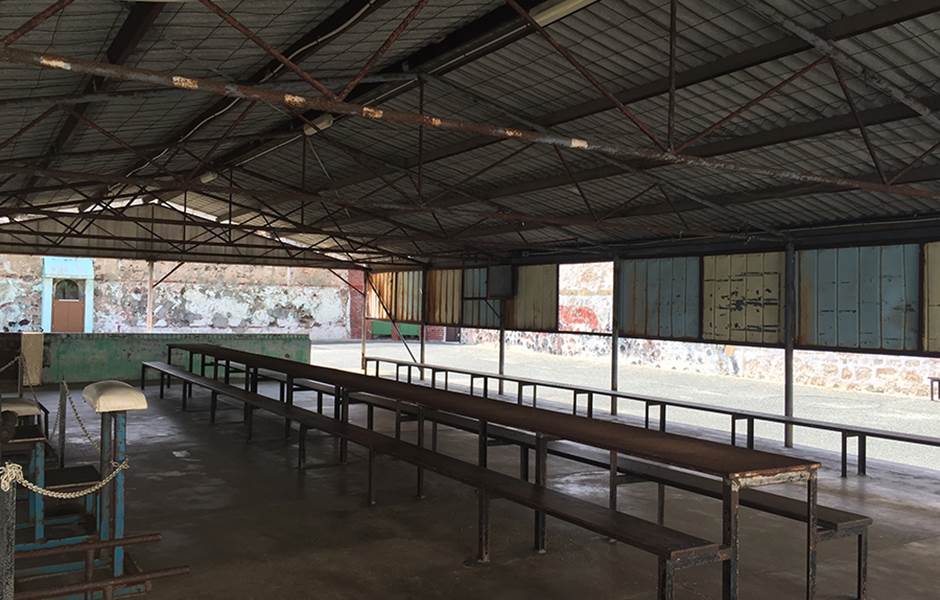
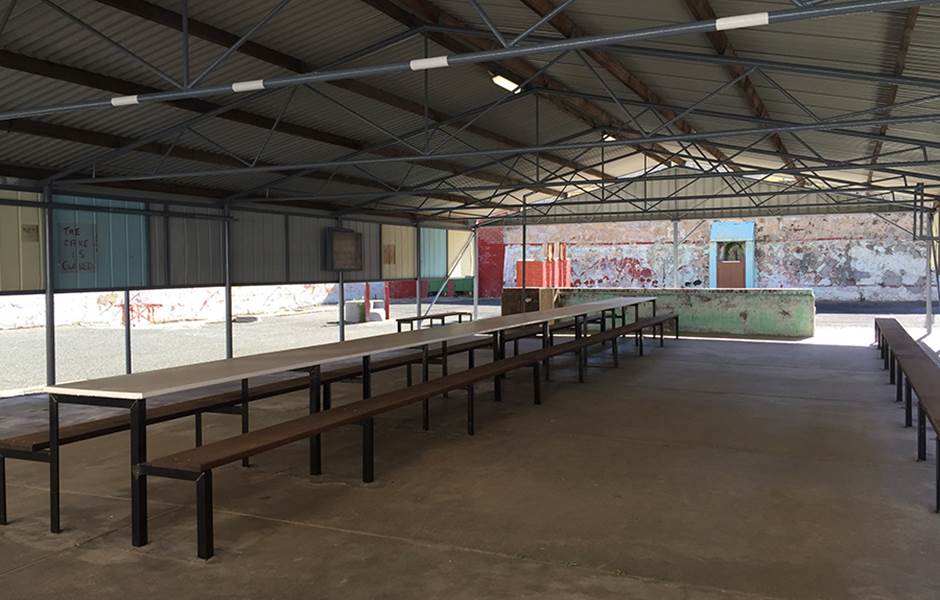
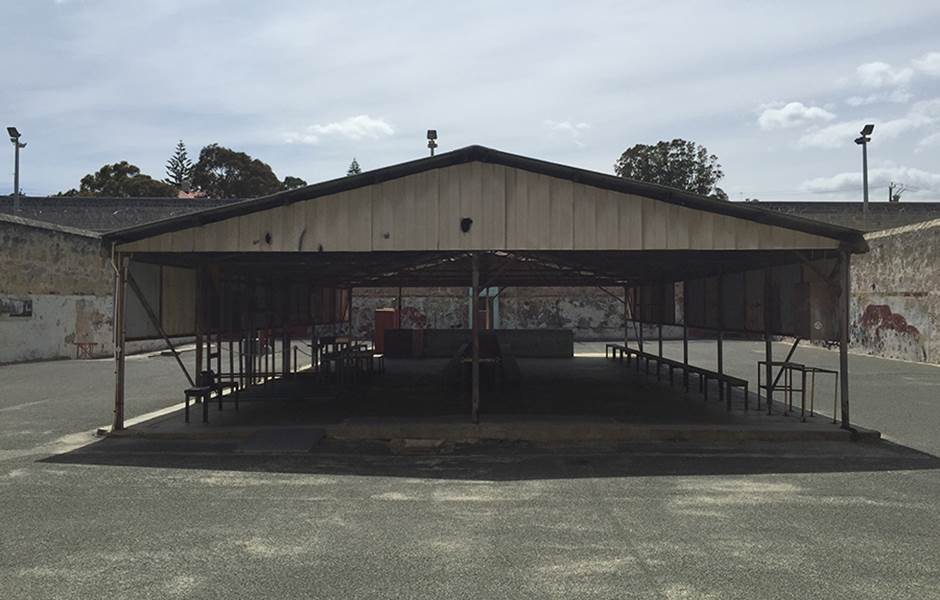
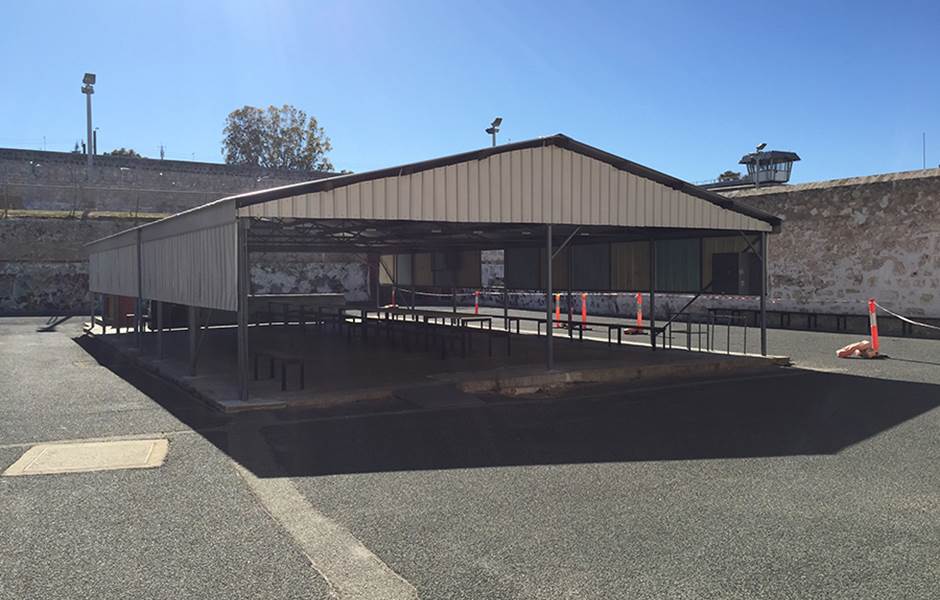
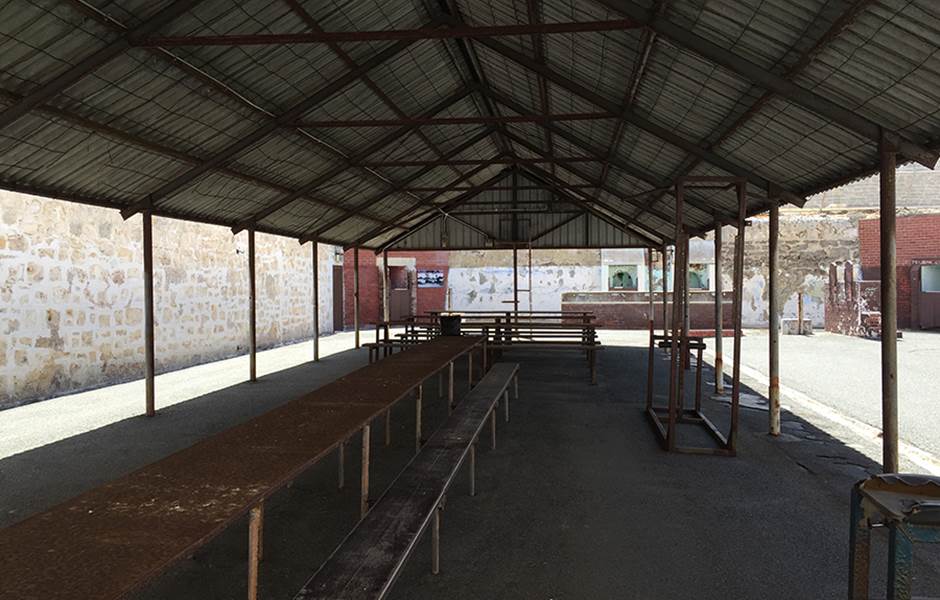

Main Parade Ground, 2016
The Fremantle Prison Heritage Precinct Master Plan proposed the Main Parade Ground in front of the Main Cell Block be retained and conserved as the primary open space of the precinct, providing an impressive setting for the Main Cell Block and unique spatial experience for visitors.
To enable visitors to experience this unique and impressive forecourt and to emphasis this important space, the Master Plan recommended that increased public access be encouraged, and its utilisation for special events and as a performance space.
Redevelopment included retaining the current garden and lawn beds but removing the brick and concrete edging, this allowed the space usable for functions and removed hazards without the loss of its modern era footprint. A representative section of this edging was retained in the fish pond garden bed on the south side of the Wray Gates. An octagonal toilet building was removed from the northern section of the Parade Ground and placed into storage for possible future relocation.
Women's Prison - Stormwater and Drainage Project and Stonework Conservation, 2015
The key aim of the works was to redirect stormwater run-off away from the original limestone masonry walls, with the intention of minimising physical intervention.
Poor stormwater and ground water drainage, in combination with previous poor repairs, contributed to the deterioration of original stonework. Some anticipatory conservation works had already been completed, including the removal of asbestos roofing, partial re-roofing, and the repair/replacement of rusted rainwater gutters and pipes.
However in a number of locations – namely the South Courtyard, the North Courtyard, the walkway between the eastern wing and the former TAFE Jewellery Studio, and the small northern toilet addition to the east wing - direct discharge of stormwater onto the masonry was still occurring.
The works carried out are summarised as follows:
- Dismantled the exercise cages in south courtyard;
- Rectified drainage issues in south courtyard;
- Installed new concrete sumps to existing downpipes and connected these to the existing stormwater service;
- Installed a new gutter and downpipe to the south courtyard link roof and connected it to the existing stormwater service; and
- Formed sterile zones, filled with crushed rock, around the walls in the South Courtyard and along the east elevation of the east wing, to enhance moisture evaporation.
Upon completion of the stormwater and drainage project, another project to restore the stone walls of the original bakehouse building was carried out.
The scope of works for this project included the conservation of the limestone walls, repairs to the windows, including steel work, the resurfacing of the exercise yards and reinstatement of the exercise cages.
The resurfacing of the exercise yards and reinstatement of the exercise cages was completed in June 2015.
Women's Prison - Adaptation to Short Stay Accommodation, 2015
In 2014 YHA, (Youth Hostel Australia) began leasing the former Women’s Prison as short stay hostel accommodation. YHA had previous experience adapting a heritage listed building into hostel accommodation as their Perth Hostel is situated in the former St John’s Ambulance building in Wellington Street Perth.
The work involved the fitting of removable partition walls to create smaller sleeping spaces in the existing buildings. The hostel provides around 200 beds targeted mainly at international travellers. The accommodation also include facilities such as a self-catering kitchen, large common areas, TV rooms, a laundry, 24 hour reception and travel and tours desks.
The hostel accommodation was opened in May 2015.
Perimeter Wall, 2015
The Perimeter Wall is a significant heritage, and well recognised, feature of Fremantle Prison. The condition of the wall varies with some areas needed immediate conservation. A conservation work project was established to carry them out.
Conservation of the Perimeter Wall is expected to be a long term project, which will be programmed on an annual basis, subject to the availability of funds. Work was programmed to attend to the more urgent works, based on a structural assessment of the wall.
With Commonwealth funding in 2014/2015 and matching State funding Fremantle Prison was able to complete extensive conservation works on the aging walls, including structural pinning and repairs on the four corners, pinning of piers to the walls, and stone and mortar repairs to wall panels and piers. In particular the north wall along Knutsford Street has benefited from a lot of conservation work which included removing an old concrete garden bed abutting the wall which had allowed rising damp and salt to damage the wall. With the pinning of the piers to the walls with stainless steel rods, the perimeter walls are more structurally sound than they have been since the day they were first constructed 150 years ago.
As of 30 April 2015, the following conservation works have been completed:
- the south west corner of the perimeter wall, internally and externally;
- the external area of the western wall behind house number 18 The Terrace up to the boundary of house number 16 The Terrace; and
- the windows at the rear of house number 18 The Terrace, including the re-pinning of piers and the restoration of stonework around the piers and windows.
Roof Replacement
An important method of protecting the buildings is to ensure the roof is in good condition and waterproof. As such roofs and guttering, as well as downpipes in some instances, have been replaced on the following buildings:
- Main Cell Block, New Division and Hospital (2005)
- Gatehouse Buildings – Visitors Non-Contact Room, Switch Room, Transport Office (2007)
- Generator Room and Toilet (2007)
- Special Handling Unit (2007)
- Walkway between Main Cell Block and New Division (2007)
- No 10 The Terrace (2008)
- No 16 The Terrace (2008)
- Women’s Prison (2009)
- East Workshops (2014)
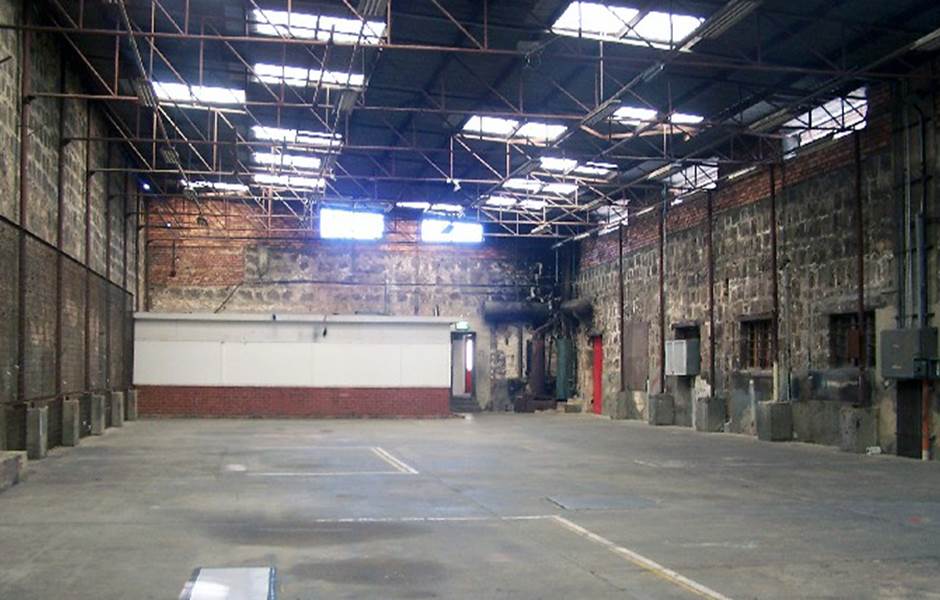

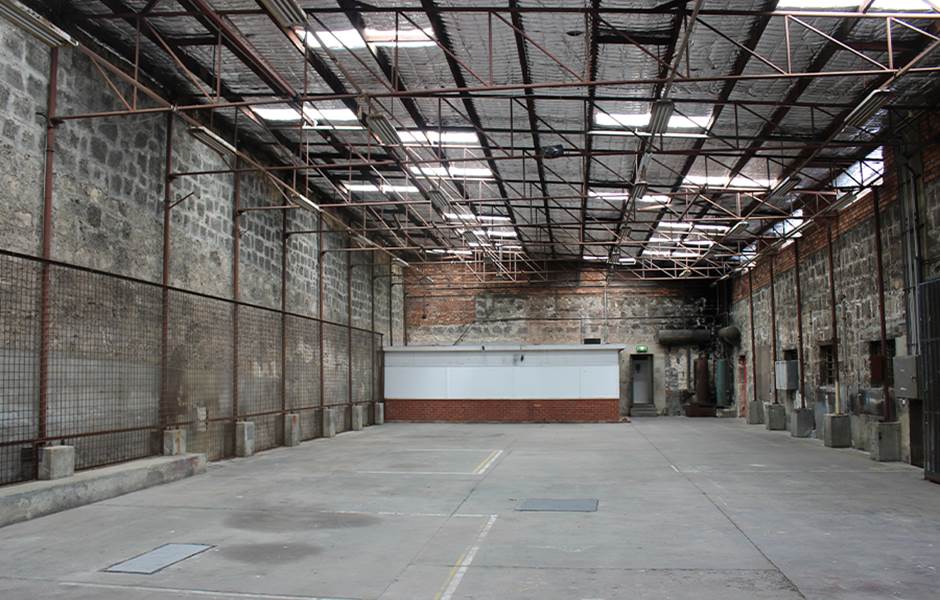
Collection Store, 2014
Prior to 2014, Fremantle Prison had no purpose-built collection storage facilities. The Fremantle Prison Collection is a diverse collection, comprised of approximately 10,000 items, including photographs, documents, furnishings, artworks, tools, clothing and textiles, institutional paraphernalia, letters, weapons and archaeological material. The collection spans the entirety of the Prison's operational life, from the convict years through to the early 1990s when the Prison closed.
The Heritage Conservation Branch decided to convert the Prison Gallery, which was climate-controlled, into a large collection storage space. A corridor was built though the Gallery and a doorway cut through the wall into the Print Shop. The Print Shop became a new gallery space, the only real difference to the current one being that it was not air conditioned. The corridor through the Collection Store leads visitors to the new gallery. The corridor itself had glass window strips so visitors can see into the Collection Store. This allows the Prison to showcase the Collection and provide visitors with a greater understanding of the scope of the Fremantle Prison's movable heritage.
The visible storage is an effective strategy to meet the dual – and contradictory - imperative of preservation and access for Museum collections. Through the Visible Storage, Fremantle Prison offers visitors a rare opportunity to view what is normally ‘behind the scenes’. The Visible Storage also includes a collections work area which will further enhance the visitors experience when the curatorial team will be at work.
The storage facility was completed in 2014, but the curatorial staff are constantly moving collection items into the space.
Boiler Chimney, 2013
The boiler house was built around 1897. The brick chimney that serviced the original wood burning boilers is thought to have been built around the same time. The original boilers were replaced around 1971 and the chimney became more of a flue than a smoke stack until it was decommissioned in 1991.
An inspection in 2013 concluded that the chimney stack was in poor condition with a potential for immanent failure in extreme windy conditions. Immediate action was taken to restore the chimney and make it structurally sound.
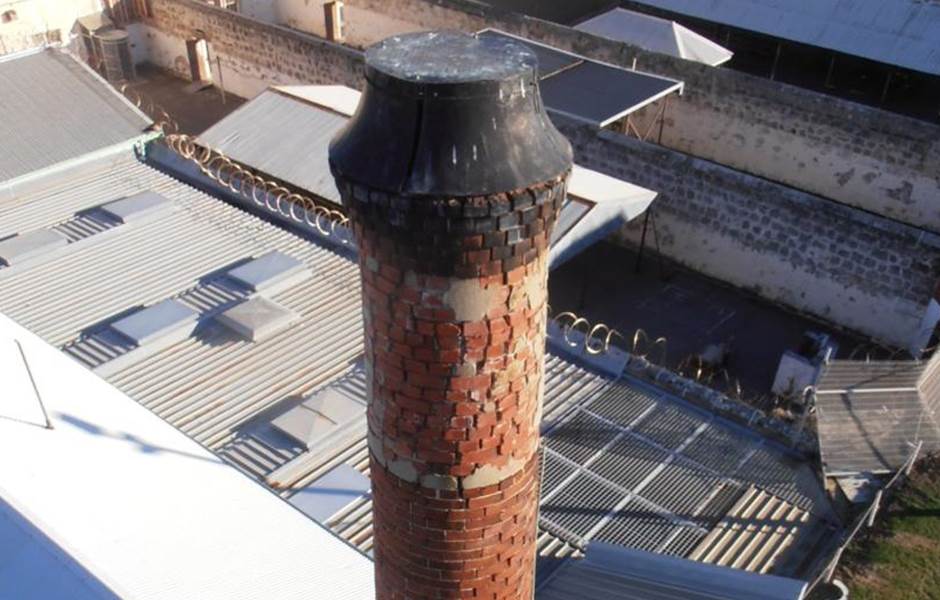
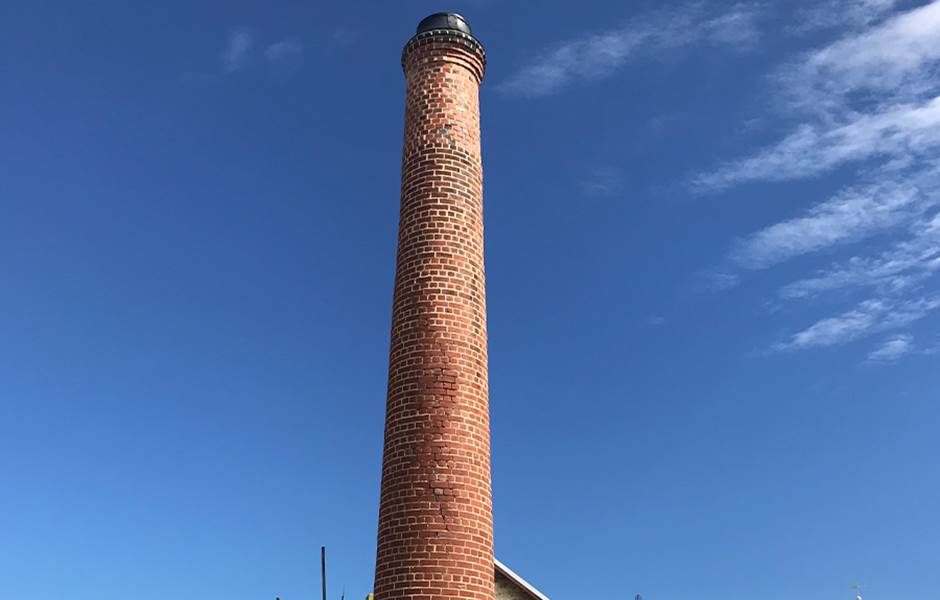
Fairbarn Street Ramp Signage, 2013
Fremantle Prison installed three new pedestal signs on the Fairbairn Street Ramp leading up to the Prison in 2013. This interpretive signage enhances the entry statement of the Prison and provides pedestrian traffic from the city centre to this historic site with interpretive information on the history and heritage values of Fremantle Prison.
The installation of this signage completed a five year signage project which has seen the installation of interpretive signage in the Prison’s Entry Complex, Main Cell Block, and along the Terrace.
The Fairbairn Street Ramp signage project was completed with the generous assistance of a Your Community Heritage grant provided by the Australian Government’s Department of Sustainability, Environment, Water, Population and Communities.
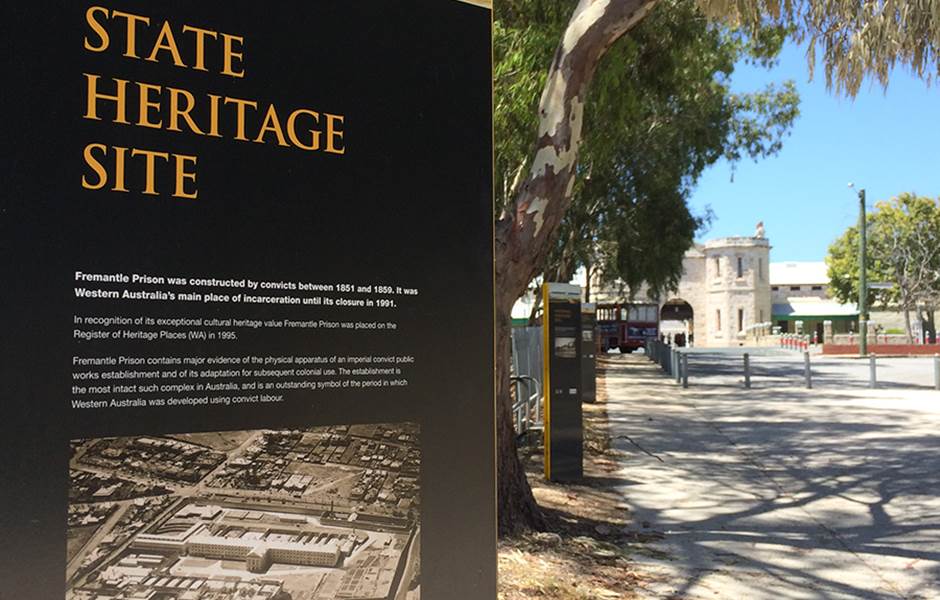
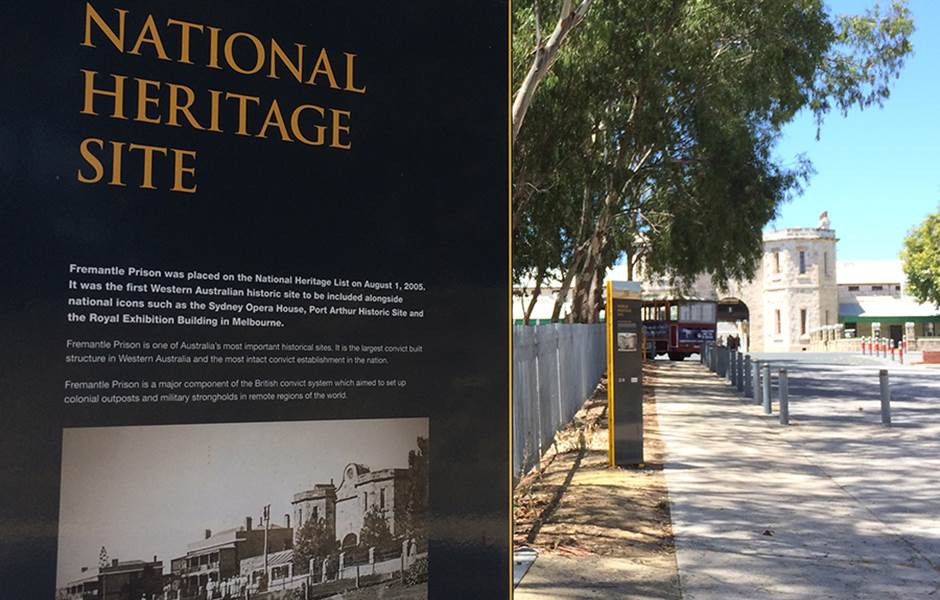
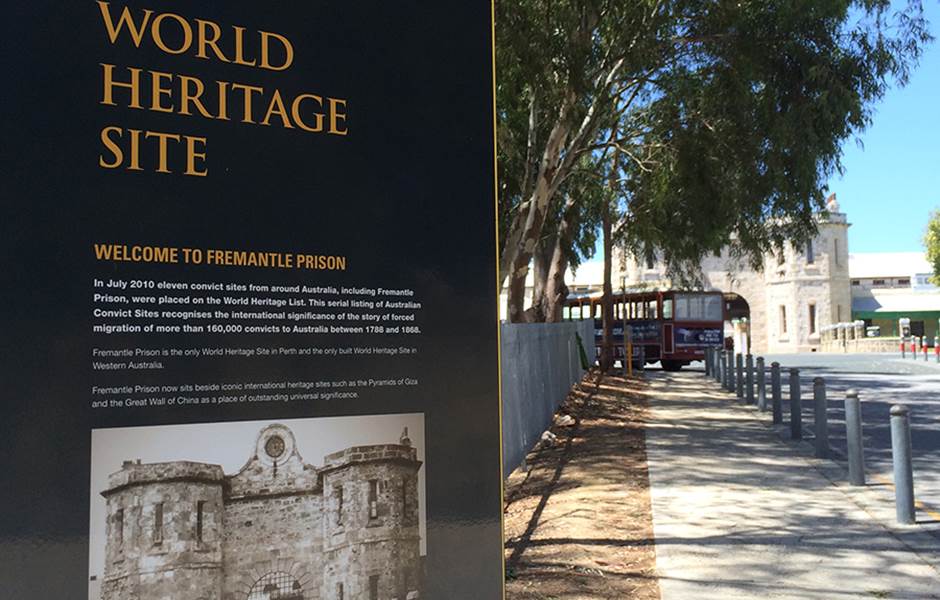
Punishment Areas Conservation, 2013
Fremantle Prison received $450,000 in funding from the State and Commonwealth Governments to undertake maintenance and restoration of the Prison’s punishment areas including the Gallows and the Refractory Block and yard. Works to the Gallows included:
- Removal of corrugated asbestos cement roof sheeting and replacement with short-sheet corrugated zincalume
- Replacement of failing downpipes and gutters
- Repairs to a fractured floor joist
- Removal of acrylic paint from internal walls
- Removal of intrusive patching with cement render to internal walls
- Repairs to render surfaces with traditional lime putty crushed limestone render
- Repairing of damaged limestone door jambs
Works to the Refractory Block and yard included:
- Removal of corrugated asbestos cement roof sheeting from 1950s brick extension and replacement with large-profile Colourbond corrugated sheeting
- Removal of acrylic paint and intrusive cement render from external walls
- Repairs to render surfaces with traditional lime putty crushed limestone render
- Installation of Nylex strip drain at base of walls to improve drainage
- Removal of acrylic paint on internal walls
- Removal of a 1980s steel framed carport style shelter adjacent to east wall of Refractory
- Removal of intrusive and redundant lighting fittings and conduit
- Removal of cement render to exercise yard walls, plus masonry repairs as required.
The work was completed in September 2013.
This project was awarded the Fremantle Heritage Awards - Conservation of a Heritage Place: Non Residential (Refractory Block Restoration Project) in 2015.
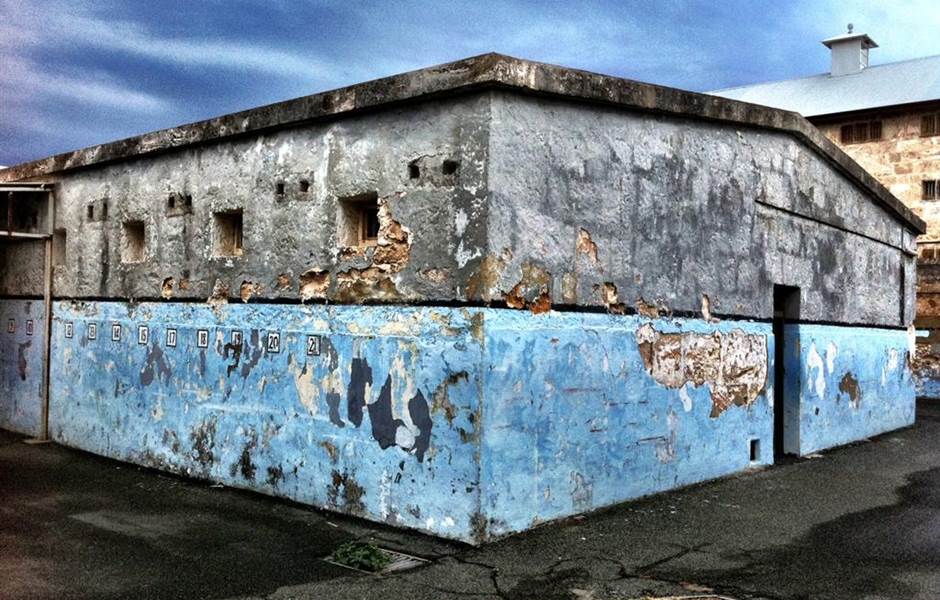
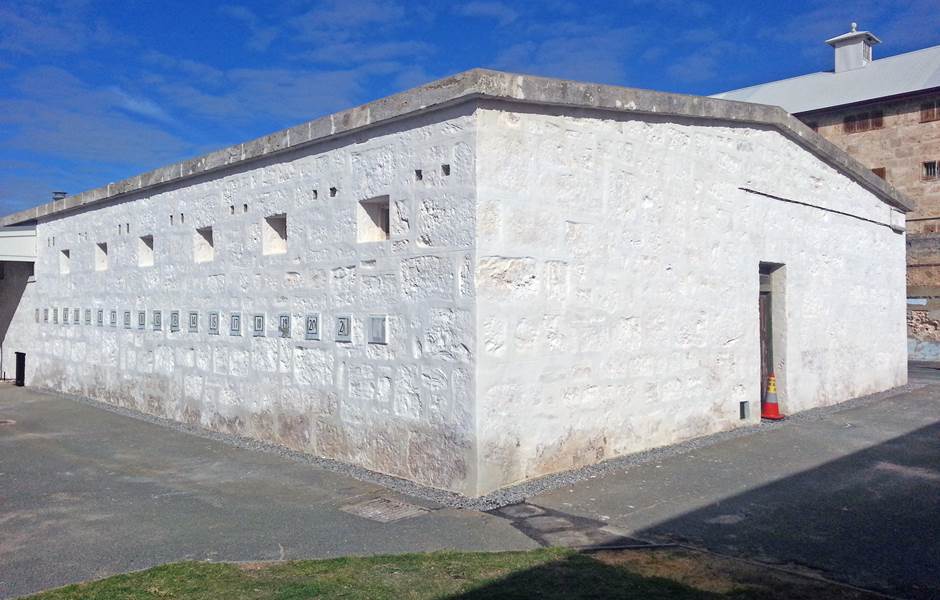
Former Officers' Dining Room - Number 14 The Terrace, 2012
The former Officers' Dining Room is divided into two sections. One of these sections has been turned into a new staff room and the other a second Visitors Centre.
The second Visitor Centre is themed as a Convict Depot and will improve the experience of visitors to the Prison offering visitors a greater understanding of the history of the Prison from its convict origins.
During initial building works a convict cellar was uncovered.
The adaptation works and fit out to display prison objects and artefacts are complete, and the centre was opened to visitors in January 2012.
Guard Post Number 4 and Walkway, 2010
The Guard Post and Walkway are situated above the Wray Gates and extend south along the wall.
The walkway was in need of conservation works as the timber bearers and joists had deteriorated due to age and weather. The guard post was in similarly poor condition and the entire structure unstable. The project also facilitated the removal of asbestos containing material.
The Guard Post and Walkway provides another point for visitors to view the Main Cell Block and Parade Ground.
This project was completed in August 2010.
New Division North and West Facades, 2011
In 2009, a report recommended that all cement renders and plastic paints be removed from the internal face of external walls on the north façade of New Division. In addition, on the west facing façade the cement render and plastic paints were to be removed from the transverse walls and the soffit of the concrete slab of the first floor.
The cell windows also need conservation, this required the dismantling of the brick window reveals and then reconstructing them without the wall ties, which had been used to secure the window jambs.
This project was completed in 2011.
The Terrace Car Park and Knutsford Street Ramp, 2010-11
The Fremantle Prison Heritage Precinct Master Plan proposed the redesign of the car parking to separate vehicular and pedestrian traffic, reduce the visual impact of car parking, and restrict vehicular access and parking at the northern end of The Terrace.
Also the ramp from Knutsford Street to the Prison was not sealed and required a stable surface to provide better access to the site.
The project was completed in 2010/2011.
The scope of works can be summarised as follows:
- Resurfaced the walkway with a bitumen stabilised limestone surface;
- Extended the existing fence along the western boundary;
- Installed new stairs from the Parry Street car park;
- Improved drainage to reduce water run off; and
- Landscaped the area at the top of the ramp.
